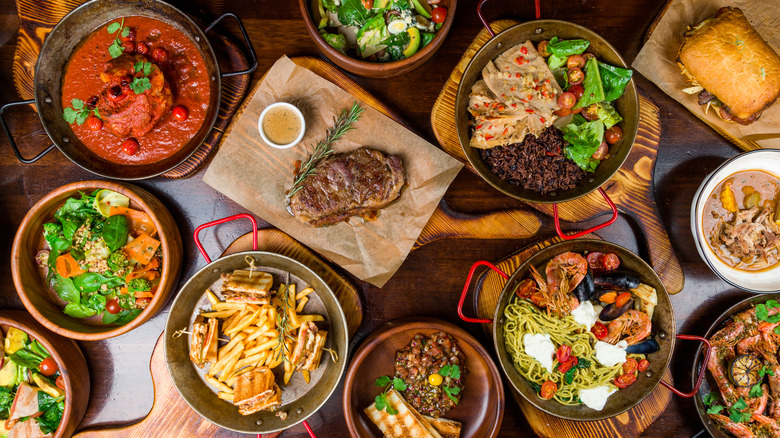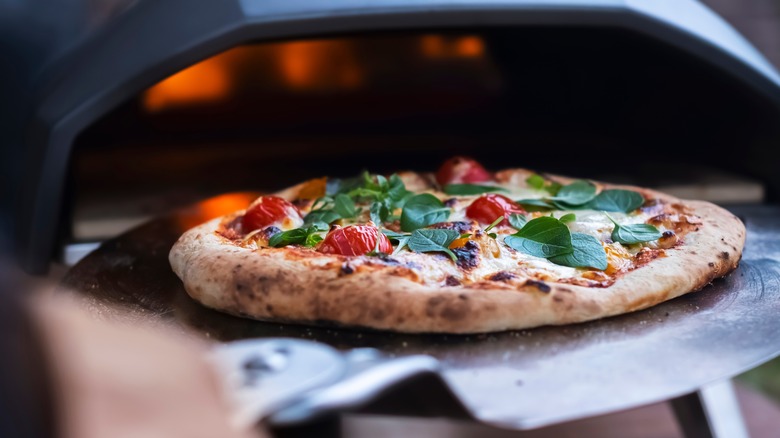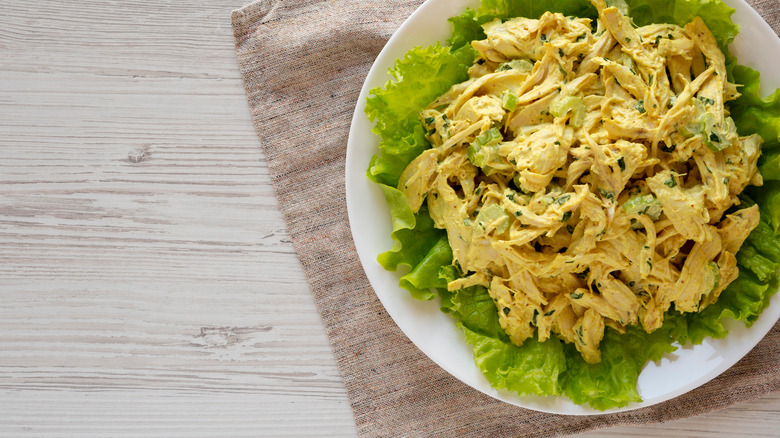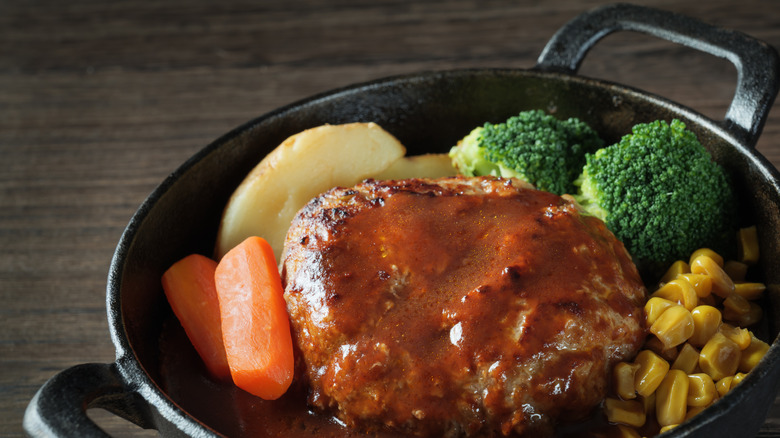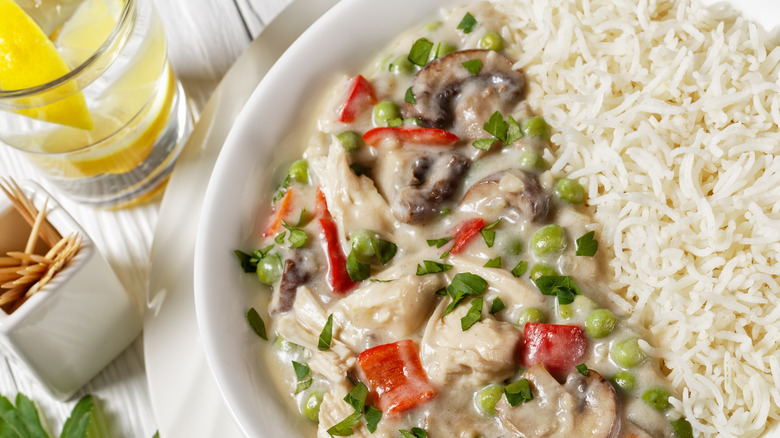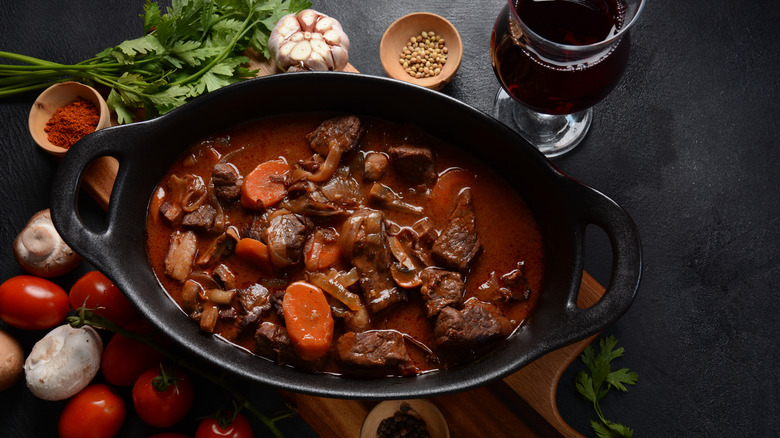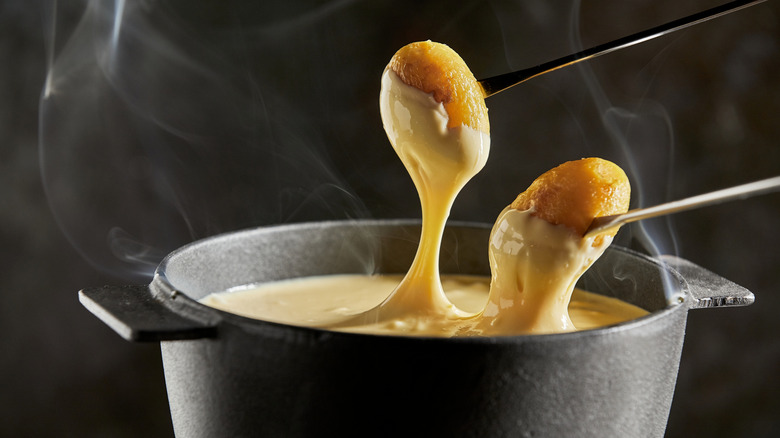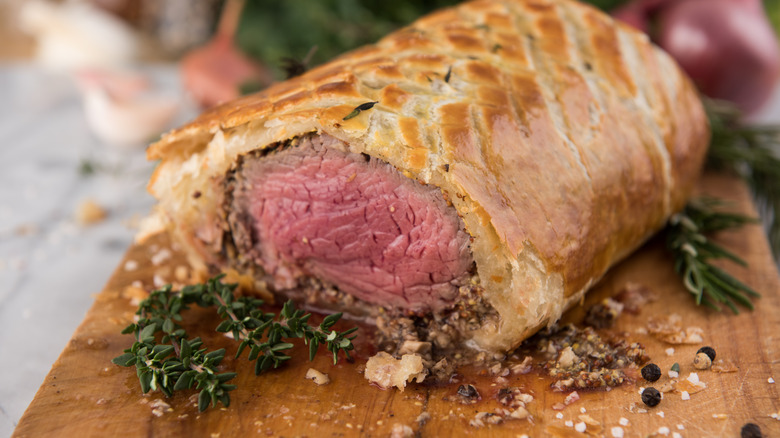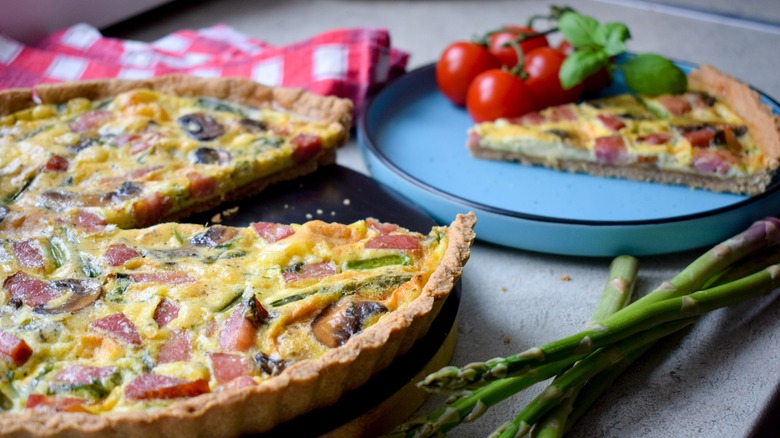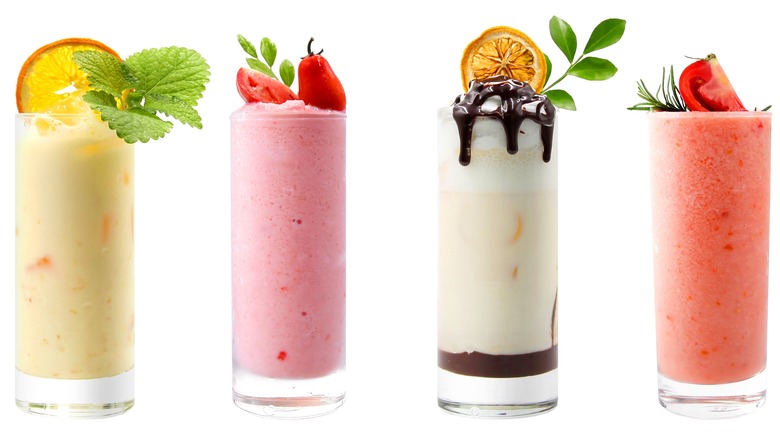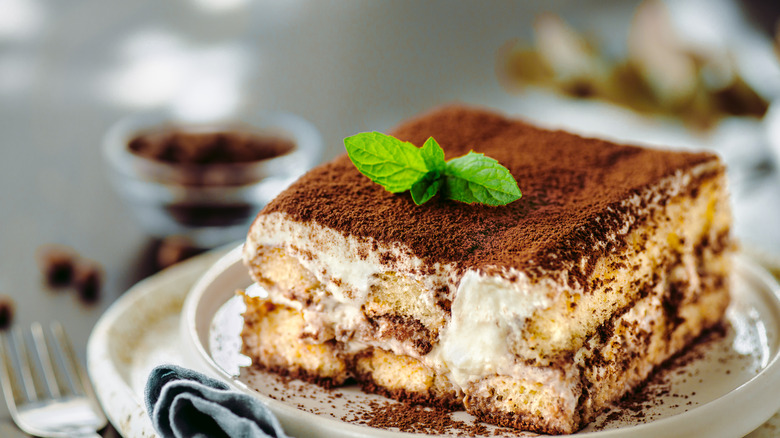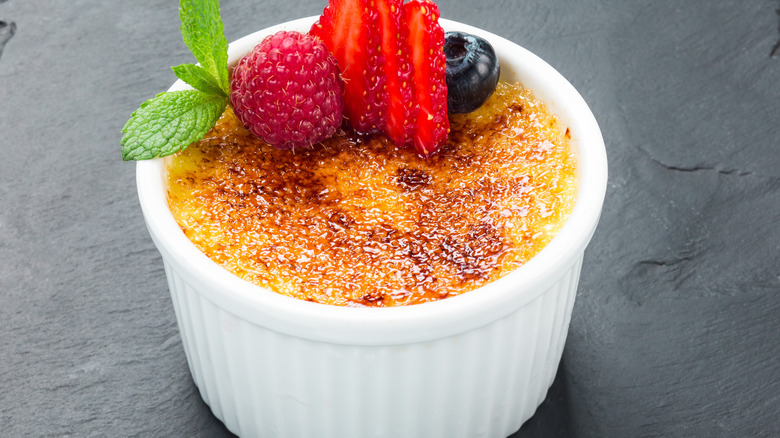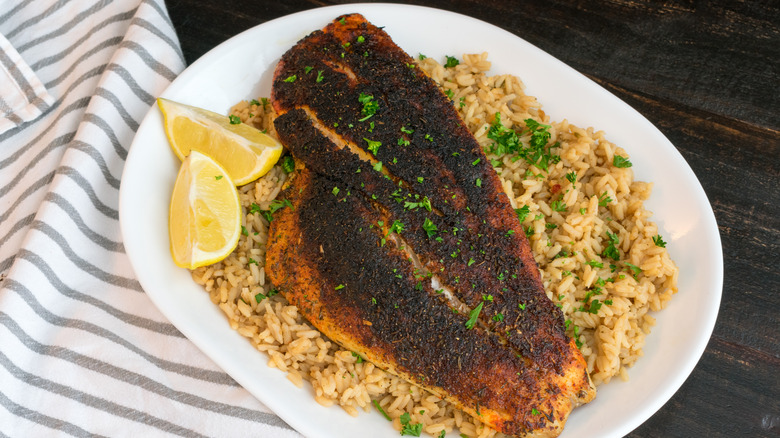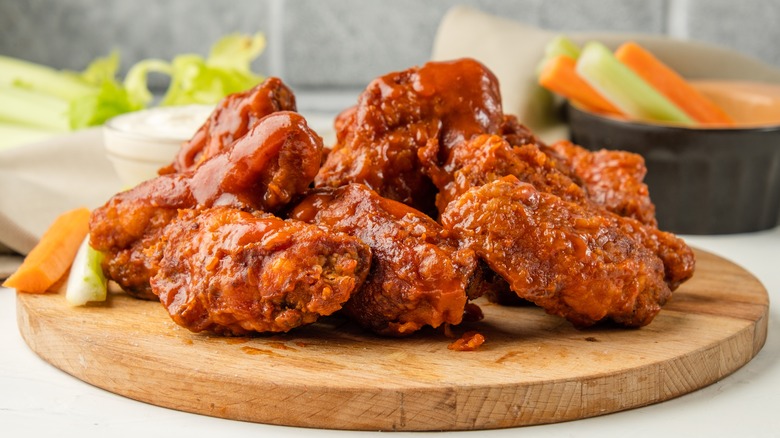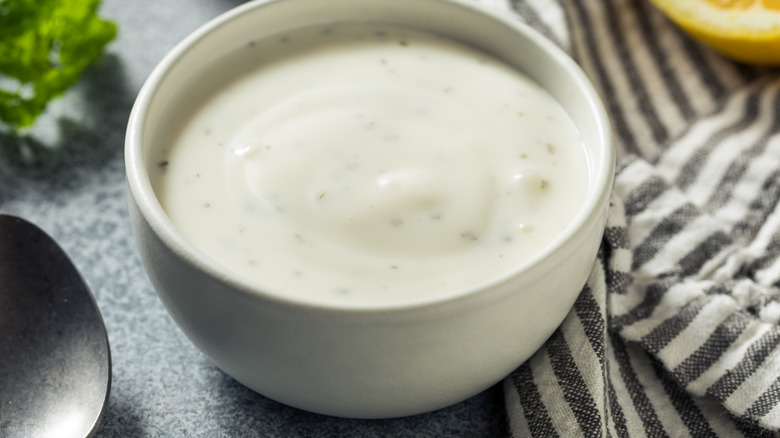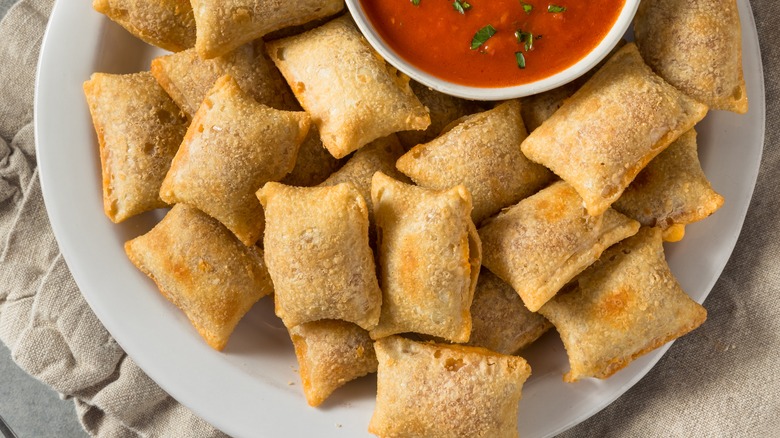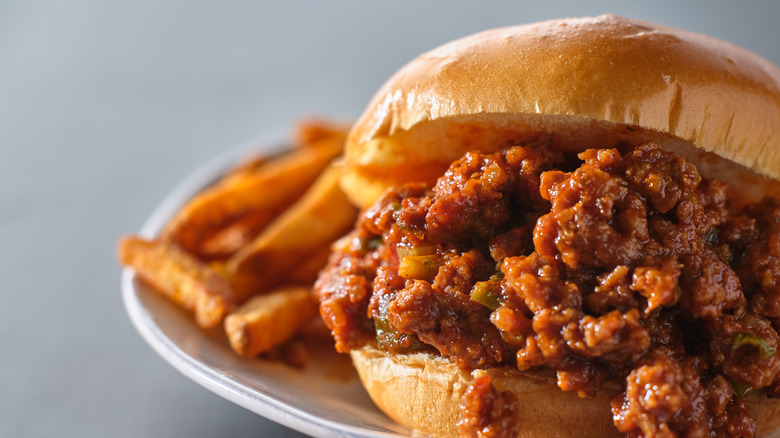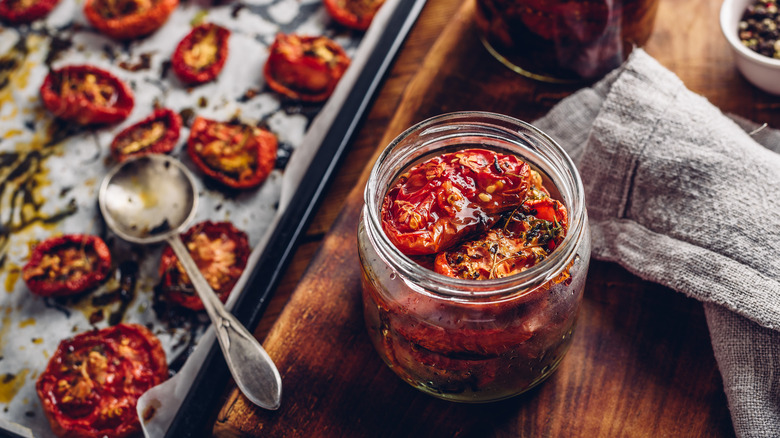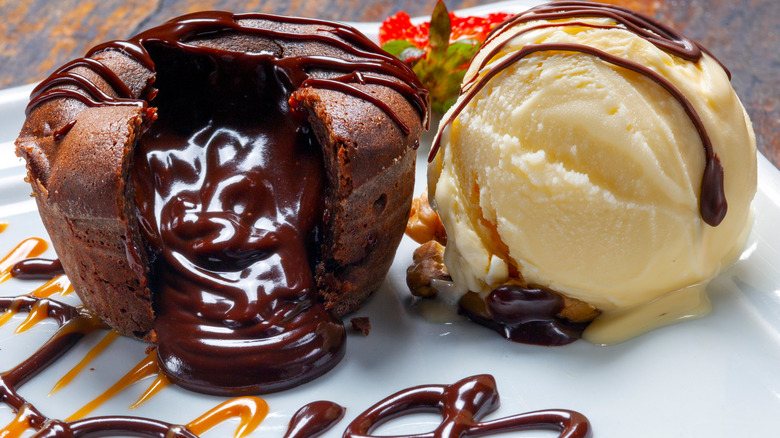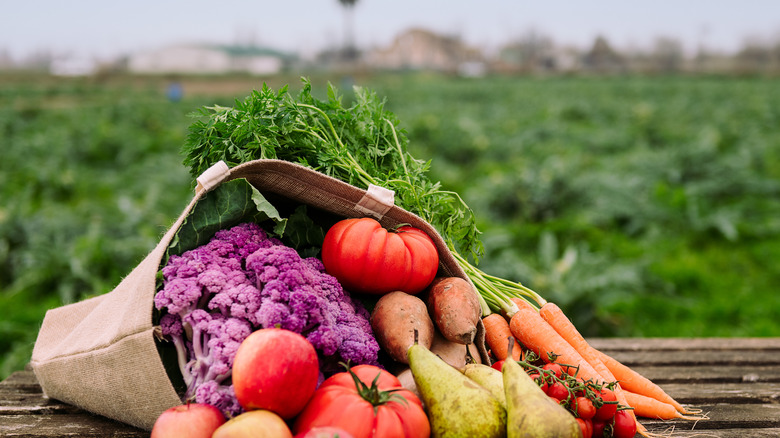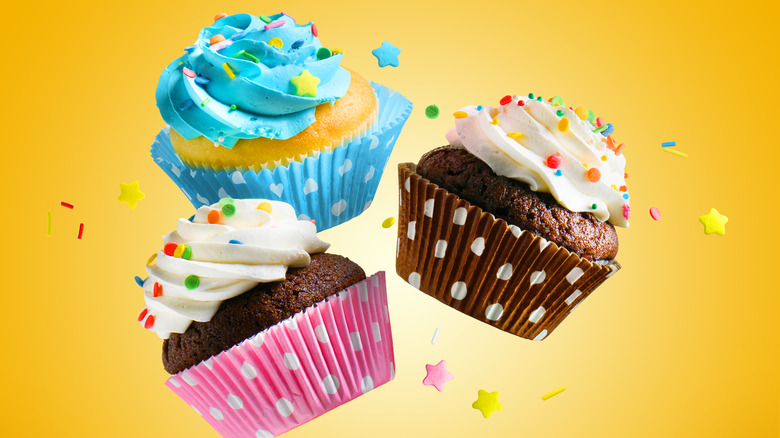The Most Popular Recipe The Year You Were Born
You're in a food and recipe rut, aren't you? Maybe you've been eating the same recipes for awhile because they are tried and true, and you've -– quite frankly -– gotten good at making them. The thing is, though, everybody knows that variety is the spice of life, and that is also exactly what our taste buds crave. So how about the next time you're left wondering what to cook for lunch or dinner, you draw inspiration from the years you, and other people close to you, were born.
You might end up pleasantly surprised by the stories and memories that these dishes bring up. And if there are none, you might end up having dessert for dinner, or at the very least, trying out a recipe you otherwise never would have bothered with. Read on to find out which recipes were popular when you were born. Most importantly, happy experimenting!
1950-1952: Pizza
Those born between the years of 1950 to 1952 were growing up at the same time that pizza was gaining in popularity. While you might think of this Italian dish as a modern invention with endless toppings, gourmet ingredients, and accompaniments, per The Washington Post, pizza was first introduced to the U.S. by Italian immigrants who brought their love for this dish with them when they arrived on American soil.
Pizza didn't officially become part of U.S. history until 1905. That's when store owner Gennaro Lombardi and chef Antonio Pero formally introduced the dish with the opening of the first pizzeria in a New York City neighborhood, aptly named Little Italy. At the time, Lombardi's became quite popular for its coal-fired brick ovens, which made it possible to bake pizzas quickly without burning them or leaving them soggy on the inside. By 1950, pizza had become exceptionally popular. That is also the year that frozen pizza was introduced to the market (via Paste Magazine).
1953: Coronation chicken
Originally named Poulet Reine Elizabeth, coronation chicken received a culinary seat at the royal table when it was created for Queen Elizabeth II's coronation in 1953. The original recipe was perfected by Angela Wood while she was a student at the esteemed culinary school, Le Cordon Bleu London. Described as a savory meal made from chicken and a curry cream sauce, it is sometimes garnished with parsley and often served on either toast points or as an accompaniment to other dishes. Coronation chicken has since become a British culinary classic.
Although Wood never established a professional career as a cook, the momentous task set before her by the school director, Constance Spry, ultimately secured her place in culinary history. Today, coronation chicken can easily be found ready-made in supermarkets as well as in countless recipe books that make it relatively easy to prepare at home.
1954-1956: Salisbury steak
Originally created by Dr. James H. Salisbury during the late 1800s, Salisbury steak contained ground beef (and sometimes other ground meats), a mix of flour, and various seasonings, and was then slathered in gravy. Per Mel Magazine, Dr. Salisbury served this "muscle pulp of beef" to Union soldiers who were suffering from diarrhea during the Civil War.
According to Food Timeline, Salisbury steak recipes were available though largely stayed under the radar for decades. However, it was during the mid-1950s that Salisbury steak really caught on as a popular dish in American homes and restaurants alike -– boosted in large part by the popularization of TV dinners. Although Salisbury steak is not a dish you'd expect to find on many menus today, for many people growing up during this era, this was one of their first introductions to the concept of ground beef.
1957: Pigs in a blanket
1957 was quite the eventful year: The Frisbee was created, the Cold War was steadily heating up, and bubble wrap was accidentally invented by two men "trying to create plastic wallpaper" (via Hobby Lark). On the culinary end of things, the name for pigs in a blanket was printed in a cookbook for the first time in 1957, per Days of the Year.
It remains unclear who developed this popular snack recipe, which is essentially a sausage wrapped in crescent rolls. However, Betty Crocker has been credited with putting the name in print, thus catapulting it into households across the U.S. Though commonly wrapped in pastry, pigs in a blanket has plenty of variations these days. In Mexico, the sausage can be found wrapped in tortillas and fried. In China and other parts of Asia, it may come wrapped in steamed pastry or cabbage leaves. Some recipes even call for wrapping the sausage in bacon and leaving out the dough-based roll (via Days of the Year).
1958: Chicken pot pie
Dating back to the Roman Empire, meat pies were quite the violent affair given that they contained living birds that "burst out" from under a pastry crust when served (via Smithsonian Magazine). By the 16th century, these pies were simplified with pastry, chicken, and gravy. And by 1796, the concept had crossed oceans to America with the recipe for chicken pot pie being featured in the cookbook "American Cookery" (via Smithsonian Magazine).
Over time, however, other ingredients have been added to create something resembling the chicken pot pie one might enjoy today. By 1958, most Americans had become familiar with chicken pot pies as well as other, more experimental versions featuring different ingredients depending on where you were located (via Los Angeles Times). The main ingredient in Virginia, for example, was carrots, while it was asparagus tips in Mississippi, and rice if you lived in South Carolina.
1959: Tuna noodle casserole
Tuna noodle casserole is one of the most iconic American dishes. While it has been revised over the many years it's been around, noodles and canned tuna fish remain the primary components. Often baked with a mushroom soup or chicken soup as a base, tuna noodle casserole sometimes has broccoli added to give it extra flavor and a pleasant crunch.
While it's largely considered "the quintessential '50s American dish," tuna noodle casserole was named in 1959 as one of the most popular recipes in America. This was after the U.S. Bureau of Commercial Fisheries conducted a survey revealing that eight out of 10 American households consumed canned tuna at least once a week, with tuna casseroles among the top three most prepared dishes (via Quaint Cooking).
1960: Chicken a la king
Served within the privacy of homes, in clubs, and at weddings, chicken a la king saw no boundaries on where it could be found. Although the dish dates back to the 19th century, its popularity was quite apparent during the 1950s and 1960s (via Quaint Cooking). It's still not clear who originally created the chicken, mushroom, and wine combo traditionally served on toast, but there are several theories.
The first is backed by The New York Times' former food editor and author Craig Claiborne, who purported that the recipe was created by chef George Greenwald in the late 1800s or early 1900s and added to the New York's Brighton Beach Hotel menu upon the approval of hotel owner Clark King II and his wife (via Quaint Cooking). Other claims cite a patron at Delmonico's restaurant named Foxhall P. Keene who had the dish created in the 1880s after his father, James R. Keene, won the Grand Prix in Paris. In another version, William King is said to have created the dish while working as a cook at Philadelphia's Bellevue Hotel. Regardless of which origin story you believe, if you were born in 1960, this recipe was popular at that time.
1961-1963: Boeuf bourguignon
Those who were born in 1961 and the few years after that arrived about the same time as popularity grew for the French dish boeuf bourguignon. Having been featured in various movies and cookbooks, the hearty mix of beef, mushrooms, and red wine catapulted in popularity. Most notably, 1961 was the year that "Mastering the Art of French Cooking" by Julia Child, Simone Beck, and Louisette Bertholle was published with its version of the recipe (via National Geographic).
It's unclear where this dish originated, though it's been associated with the Burgundy region of France. In addition, it seems there are several variations to the classic recipe. While some recommend veal rather than beef or white wine as opposed to red, some more complicated recipes -– like the one created by famed chef Thomas Keller -– call for bacon, short ribs, and veal or beef stock (via Wine Spectator).
1964: Fondue
Those born in 1964 who are also cheese lovers can only be praised for their peak timing. This was the year Americans were first introduced at the New York World's Fair to fondue, which quickly became popular across the nation, per Paste Magazine. Fondue is translated from the French "fondre," meaning "to melt." But the origins date back to between 800 B.C. and 725 B.C. with descriptions of cooking with wine, goat's cheese, and flour (via BBC). Some say fondue was a dish relegated to peasants in a region of Switzerland called Valais who wanted to use up aging bread, cheese and wine.
Today, fondue remains a dish around which groups gather and dip bread and a host of other ingredients while they make their way through the fondue bowl. In addition to cheese, other varieties call for using melted chocolate, broth or hot oil. In Switzerland, different restaurants offer different ingredients to dip into the cheese, including pearl onions, potatoes (a take on cheese fries, if you will), and cornichon.
1965: Beef Wellington
Described as "the ultimate indulgence" by celebrity chef Gordon Ramsay, beef Wellington was growing in popularity in 1965. It enjoyed further popularity a year later when it was featured in an episode of Julia Child's TV show, "The French Chef." And although it's lauded as a classic U.K. dish -– its origins are believed to be French, per Foods of England – beef Wellington seems to have plenty of ties to the U.S. as well (via Gordon Ramsay Restaurants).
It was apparently Richard Nixon's favorite dish and was included in a White House cookbook. A version was referenced in the Los Angeles Times in 1903, and it was also listed in a 1939 restaurant guide for New York City (via Gordon Ramsay Restaurants). Supposedly named after Arthur Wellesley, the first Duke of Wellington, the dish was traditionally made using a whole filet of beef and pâte de foie gras wrapped in pastry and served with a Madeira sauce. Today there are countless variations for both the fillings and casings used.
1966-1969: Tunnel of Fudge Cake
Long before baking contests were televised to global notoriety (yes, we mean you, "The Great British Bake Off"), home bakers could showcase their talent in contests like the Pillsbury Bake-Off. That's where the Tunnel of Fudge Cake first made a name for itself. The cake had a center of fudge and nuts and was baked in a Bundt pan (via Cook's Info).
It was entered into the baking contest by Ella Helfrich in 1966. Made using Pillsbury's Double Dutch Fudge Buttercream Frosting Mix, the cake placed second in the contest. But more importantly, the company received more than 200,000 letters from home bakers requesting the recipe as well as information on where to find their own Bundt cake pans. Pillsbury went on to develop an updated recipe with cocoa powder rather than the frosting mix, which had been discontinued. However, the recipe has remained a favorite for chocolate lovers.
1970-1972: Quiche
At the start of the decade that would go on to see Richard Nixon's resignation from the presidency and the release of the first Star Wars movie, quiche was making its mark as a go-to food. Per New England Today, quiche was a popular brunch dish or appetizer that could be served hot or at room temperature. A 1972 cookbook titled "Favorite New England Recipes" included directions for making a spinach quiche.
Not only was its signature combination of eggs, milk, cheese, meats, and vegetables delicious on its own, but according to The New York Times, it could also make magic with food that has been sitting in the refrigerator for too long. For instance, leftover turkey and chicken could easily be converted into a quiche, and leftover rice could be combined with some of the key ingredients to make rice pudding.
1973: Smoothies
Although the word "smoothie" started making the rounds during the early 20th century, the evolution of its meaning is intertwined with the creation and popularization of blenders (via LEAFtv). By the 1960s and 1970s, the U.S. became the hub of a natural food trend that included smoothies made of fresh fruits, ice, and fruit juice.
The mass popularization of smoothies is largely tied to Steve Kuhnau, who established the first Smoothie King in 1973 in Louisiana. Having developed various recipes using what are now standard additions to many homemade smoothies -– like protein powders and yogurt -– Smoothie King spread in popularity and now has more than 1,300 locations worldwide.
1974-1975: Carrot cake
If you've ever justified that extra slice of carrot cake as healthy just because it contains a vegetable, nuts, and raisins, you would have channeled the overriding theory that made it so wildly popular in the 1970s. Originally created as an updated version of European steamed puddings and medieval English baked puddings, carrot cake dates as far back as 1783, per the Naples Daily News.
Pillsbury Baking Company had conducted enough research not only to find a carrot pudding recipe in "The Thirteen Colonies Cookbook" published in 1975 but also to come up with its own version centered on spices and carrots. Carrot cake continued to rise in popularity and eventually earned its place as one of the top five food fads of the decade (via Naples Daily News).
1976: Chocolate truffles
According to The Nibble, legend has it that the first chocolate truffles were created in the kitchen of famed chef Auguste Escoffier during the 1920s. Named after the black truffle fungus because of their similar appearance, chocolate truffles consisted of a ball of chocolate and cream rolled in cocoa powder. Today, chocolate truffles can contain an array of other ingredients, from nuts and caramels to peppercorns and paprika.
If you were born in 1976, you share a birth year with Alice Medrich's first bake shop, Cocolat, in Berkeley, California, which became wildly successful in part due to the owner's hallmark chocolate truffles. Her treats were so sophisticated that Michael Wild, the French-born owner of Baywolf Restaurant in Oakland, California, praised them as the first he had tried in the U.S. that "tasted like real chocolate" (via The New York Times).
1977-1979: Pasta primavera
While one could easily assume that any dish with pasta would trace back to Italy, the pasta primavera was, according to the National Post, a happy accident that originated at a mansion in Nova Scotia, Canada. Although some attribute the creation of pasta primavera to cookbook author Ed Giobbi and Sirio Maccioni during a fishing trip there, others elaborate on the fishing trip story with the addition of Maccioni's wife, Egidiana, who presented an improvised mix of mushrooms and greens, cream, and olive oil tossed into pasta to visitors.
The dish, at the time called spaghetti primavera, was offered as a special at the Manhattan restaurant Le Cirque, co-owned by Sirio Maccioni and Jean Vergnes (via National Post). The dish got rave reviews, though its preparation was reportedly inconsistent and not always done well. It was only after a scathing 1977 review from The New York Times that Maccioni and Vergnes perfected the recipe. That year pasta primavera took Manhattan by a storm and has remained a popular recipe to this day.
1980: Granola
The increase in health consciousness of the 1970s gave way in 1980 to a spike in the popularity of granola. It wasn't a novel concept, though. According to the Los Angeles Times, granola had already become popular during the 1960s when its marketing was touted as a snub to previous generations' unhealthy lifestyles.
Granola went fully mainstream in the 1970s after General Mills developed Natural Valley Granola, and later, cereal bars. By 1981 Quaker had introduced its Chewy Granola Bars (which were topping the sales charts) to compete with General Mills, and that soon began an era of fierce granola competition with other companies like Hershey Foods and Carnation (via Los Angeles Times).
1981: Tiramisu
For those who are unfamiliar with the Italian language, you may be thrilled to know that the reason you feel so good while digging into tiramisu is -– quite literally –- in the name. The dessert is a decadent mix of mascarpone cheese whipped with rum, sugar, and heavy cream and then layered with ladyfingers that have been dipped in espresso. The Italian word tiramisu translates to "pick me up."
Per National Geographic, the origin story of tiramisu is fiercely debated to this day. Some believe it was created as an aphrodisiac in the 19th century. Others say it was developed at Le Beccherie restaurant, which opened in the 1970s in the Italian province of Treviso. Another version claims there was a handwritten recipe of tiramisu in 1959 from another region of Italy. Nevertheless, the dessert took the U.S. by a storm in 1981, when Lidia Bastianich featured it on the menu of her new Felidia restaurant in New York City's Upper East Side (via Eater).
1982-1984: Creme brulee
A few years after Le Cirque owner, Sirio Maccioni, upleveled the pasta primavera recipe within New York society, he had his staff create a dessert that went on to become one of the restaurant's most popular items. Although versions of creme brulee date back as far as medieval times, the dessert has also undergone many revisions (via Saveur).
Its name borrows from the French words for "burnt cream." Maccioni's staff created an updated version of this sweet masterpiece after he tasted crema catalana during a family visit to Spain to watch the World Cup in 1982 (via New York Post). The restaurant's creme brulee soared in popularity, and by 1984 variations had popped up across the country — creme brulee with berries, with nuts, with mint, and even with orange liqueur (via The New York Times).
1985: Blackened fish
The early 1980s were mostly characterized by the booming popularity of desserts. At the same time, though, blackened fish was steadily making its own waves on the way to claiming its culinary moment in 1985 during what The New York Times dubbed the "year of surprises." Restaurants had introduced a variety of Cajun-style dishes. Among these were blackened tuna, blackened eggplant, blackened snapper, blackened prime rib -– the possibilities were endless.
According to the Chicago Tribune, the unstoppable food trend could be traced back to Paul Prudhomme, chef and owner of K-Paul's Louisiana Kitchen in New Orleans. He created a blackened redfish recipe for his menu, and patrons were so thoroughly taken by the flavors that it not only became his signature dish, but other restaurants also quickly followed suit with their own versions.
1986-1991: Buffalo wings
It's hard to believe that something as delicious as Buffalo wings didn't actually exist until 1964. Fried chicken wings had already been a longstanding staple in the South, but according to the National Chicken Council, the concept of Buffalo wings came into being in Buffalo, New York, when Anchor Bar co-owner Teressa Bellissimo opted to combine leftover chicken wings with hot sauce. They were immediately added to the restaurant's menu.
Per Time, Buffalo wings remained a regional food relegated to the New York area for years, but by the mid-1980s, the concept had grown progressively more popular across the country. In 1990, a version of Buffalo wings went national with the McDonald's launch of its spicy Mighty Wings.
1992: Ranch dressing
Every iconic salad needs a dressing that is just as iconic. In some cases, salads are only iconic because of the dressing. Enter this country's beloved ranch dressing. According to Slate, ranch dressing was created by Steve and Gayle Henson, who opened Hidden Valley Ranch in California in 1954. The dressing they served guests was soon in demand. They later started selling herb packets to mix with mayonnaise and buttermilk so people could make their own ranch dressing at home.
By the time the Clorox Company purchased the Hidden Valley Ranch brand in 1972, the dressing had become a local specialty with a steadily thriving market. In the years that followed, the recipe was reformulated to make it easier to bottle and use. By the mid-1980s, casual dining and fast food joints were using ranch dressing in their recipes, thus spreading its popularity across the country. By 1992, ranch had become the top-selling salad dressing in the U.S. and has continued to garner notoriety in many households to this day.
1993: Pizza rolls
As if pizza wasn't popular enough, businessman Jeno Paulucci put an Italian spin on egg rolls by filling delicious little pockets of dough with cheese and sauce and calling them pizza rolls (via Michigan Daily). They started off as a ready-made frozen product offered through his food company Jeno's Inc., which was founded in 1968. Pizza rolls quickly grew popular.
Paulucci sold Jeno's in 1985 to Pillsbury, which also owned Totino's. In 1993, the snack was rebranded to become what is still known today as Totino's Pizza Rolls (via Totino's). The company's website claims its trademarked snack is the best-selling hot-snack food in the U.S.
1994: Sloppy Joes
The origins of sloppy joes are a bit sketchy. Among them are claims that the sandwich may have been inspired by a Cuban dish and served in a Havana restaurant that was often unkempt and became known as Sloppy Joe's. Others suggest the sandwiches may have been created by an actual Joe based in Iowa who added tomato sauce to his cafe's loose meat sandwiches. Some also credit Ernest Hemingway, a fan of the Havana restaurant who encouraged a friend to rename his bar in Key West, Florida, in the 1930s and recreate the sandwich into what it more closely resembles today.
According to Mel Magazine, the term "sloppy joe" can be traced to at least the 1880s, when it was considered a jab for people who were unkempt or for low-end restaurants. The name is also befitting of this dish, which consists of a relatively messy mix of ground beef, sauce, onions, green peppers, and spices. But it was 1994 when the sandwiches got a huge boost in popularity with the SNL sketch featuring Adam Sandler singing about the school lunch lady, played by Chris Farley, and sloppy joes.
1995-1996: All things sun-dried tomatoes
Food in the 1990s was characterized by two significant shifts, per Taste. The first was the rise in the Mediterranean diet's popularity. The other was that more people were eager to experiment with home cooking, given the rising popularity of magazines and television shows about food and cooking. Between 1995 and 1996, sun-dried tomatoes peaked in popularity as more and more were being imported from Europe for all those home cooks to use in a myriad of dishes.
Moreover, "Sun-Dried Tomatoes," a cookbook cowritten by Ethel and Georgeanne Brennan and released in 1995, was so popular that it had to be printed several more times. Today, sun-dried tomatoes have lost some of their popularity. But if your internal farmstead persona is ever so inclined, they are still relatively easy to make. All you need are Roma or San Marzano tomatoes, a little bit of salt to syphon their moisture, and exposure to the sun's rays while covered in a cheesecloth for a couple of days (via Food & Wine).
1997-1998: Chocolate lava cake
Most people love a good, molten lava cake, but it seems the history of this popular dessert is just as fascinating as it is yummy. According to Thrillist, when chocolate lava cake was introduced to "the happiest place on earth" in 1997, it could only be purchased in the more expensive restaurants located inside Disney World rather than the more casual eateries at the park.
This was hardly surprising, though, given that chocolate lava cake had already grown exceptionally popular in upscale restaurants across New York City and Los Angeles as well as in France. The dessert became even more mainstream once Chili's began selling its version that it called a Molten Chocolate Cake in 1998.
The trendy treat started as an accident in 1987 when French chef Jean-Georges Vongerichten had miscalculated oven temperatures and produced 500 underdone chocolate cupcakes for a private party (via Thrillist). But after receiving a standing ovation from the guests, he immediately added it to the menu at the Lafayette restaurant in New York City, and an iconic dessert was born.
1999: Local and farm fresh
Dubbed "the year that transformed British food forever" by Delicious Magazine, 1999 was the year that Jamie Oliver's "The Naked Chef" series launched. Nigella Lawson's book, "How To Eat," also released that year, became an instant sensation. These spikes in food positivity were especially welcome, given that Britain had been muddled in beef export bans and salmonella scares in the previous years.
On a commercial, and in some ways more entertaining level, the British food scene was thriving. Given the messaging delivered by the emerging food celebrities, there was great emphasis on local, farm-fresh ingredients centered around simplicity and giving people the confidence to create delicious meals from basic elements.
2000-2005: Cupcakes
If you were born between 2000 and 2005, you were definitely too young to be watching Carrie Bradshaw declare her crush on Aidan while biting into a cupcake at Magnolia Bakery in New York City (via HuffPost).
With an already longstanding history dating back to the introduction of the Hostess CupCake in 1919, cupcakes were propelled to superstar culinary status with this cultural moment. By 2003, Crumbs had launched, with its gourmet -– and supersized –- cupcakes quickly becoming a cult favorite. In 2005, Magnolia Bakery's cupcakes were once again featured on TV. This time it was an SNL excerpt starring Chris Parnell and Andy Samberg. Cupcakes peaked, then fell from grace in the coming years. But they sure did make many taste buds dance — try finding someone who doesn't smile at the sight of a colorful cupcake.
